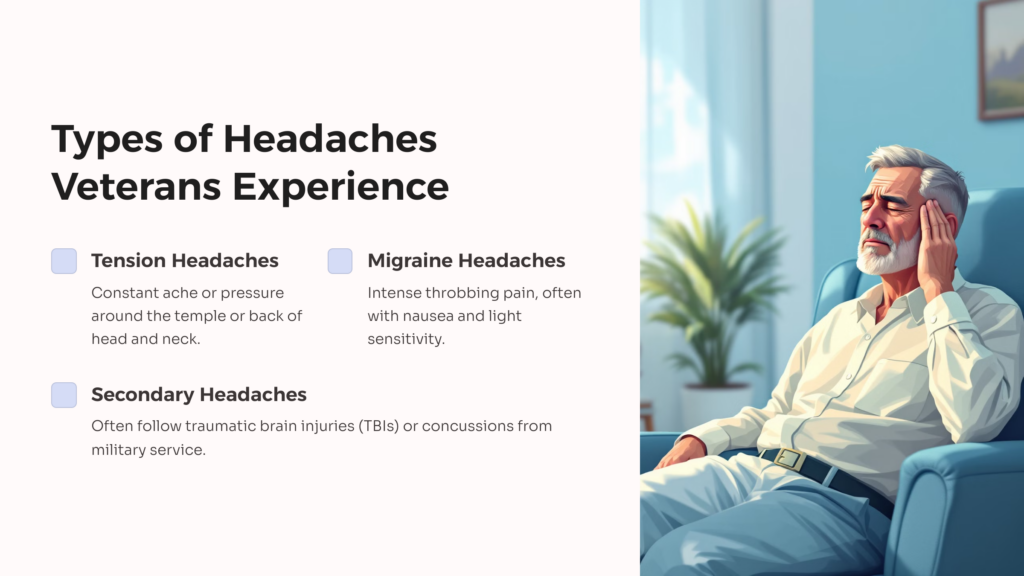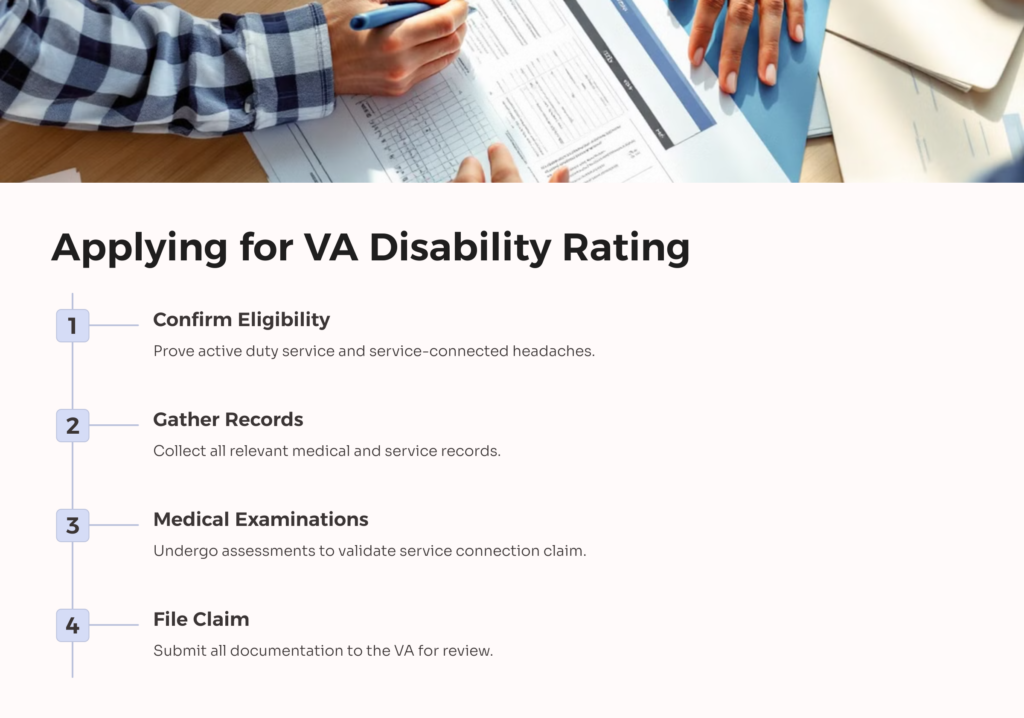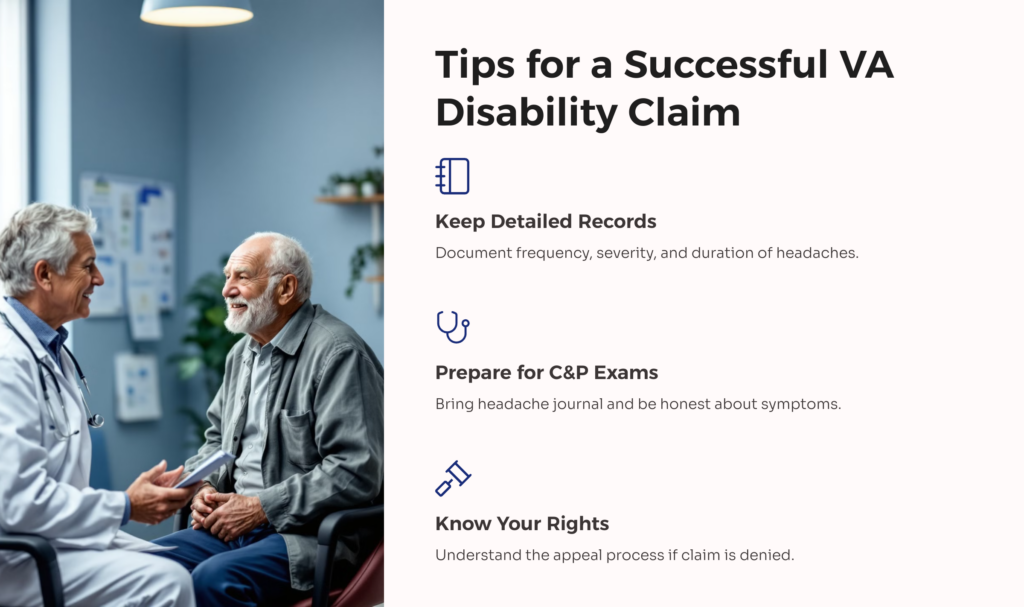Introduction
Service to one’s country is honorable, but it often comes with physical and emotional sacrifices. Among the physical struggles many veterans face, headaches are prevalent, often as vestiges of active service roles. These are not ordinary headaches; they can be frustratingly persistent and debilitating, adversely impacting a veteran’s quality of life. Some veterans might not realize, but headaches are one of the conditions that qualify for a Veterans Affairs (VA) disability rating, offering them financial support and access to additional healthcare services.
Definition and Types of Headaches

Veterans suffer from different types of headaches, ranging from tension headaches, migraine headaches, to other secondary headaches induced by conditions like a traumatic brain injury (TBI). Tension headaches, the common type, manifest as a constant ache or pressure around the temple or back of the head and neck. A migraine episode, on the other hand, is an intense headache characterized by throbbing pain on one side of the head, often accompanied by nausea, vomiting, or sensitivity to light and sound. Prostrating migraine attacks force you to stop all activity and may render you incapacitated for hours or even days. Migraine headaches could emanate from service-linked factors such as stress or exposure to loud noises. Secondary headaches, although less common, can follow TBIs or concussions suffered during military service, and can be persistent and severe. All of these headaches, with their debilitating impacts, manifest as a consequence or after-effect of active military service and thus have significant relevance to veterans’ healthcare.
Understanding VA Disability Ratings for Headaches
So, what exactly constitutes a ‘disability’ according to the VA? According to the VA, a veteran is disabled due to their military service if they have a condition that affects their body or mind to a degree that it impairs their ability to secure or follow a substantially gainful occupation. The VA employs a rating system for disabilities, with a range from 0% to 100%, where each disability rating translates to different levels of financial support.
For headaches, this rating is broken down into several levels, where a 0% rating acknowledges the presence of headaches but notes that they do not significantly impact the veteran’s life or ability to work. A 10% disability level signifies that headaches cause a mild level of interference to the veteran, while a 30% rating indicates more frequent, completely prostrating, and prolonged attacks. A 50% rating indicates severe economic inadaptability, and the headache condition is deemed very severe. A rating of 100% is given in rare cases where the veteran’s disability is extremely severe, and they cannot work.
Applying for a VA Disability Rating for Headaches

The process of applying for a VA disability rating for headaches involves filing a disability claim, which typically involves several steps. The first is confirming eligibility, i.e., proving that the veteran served in active duty, and the headaches are a result of that service. Following this, the veteran will need to gather all relevant medical and service records to prove the service connection. This can be a direct service connection, where a headache condition directly resulted from service, or an aggravated service connection, where a pre-existing headache got worse due to military service.
Medical examinations would also be required, offering an in-depth assessment of the veteran’s headache condition and validating their service connection claim. Documented evidence of frequency, severity, and duration of headaches, treatments sought, and treatments’ effectiveness are vital at this stage.
Tips for a Successful VA Disability Claim for Headaches

Ensuring a robust medical record and having the right documentation is crucial to a successful VA disability claim. The more medical evidence you have, the better link can be made between your headaches and your military service.
Compensation & Pension (C&P) exams play a critical role in VA disability claims. Veterans seeking disability benefits for conditions like headaches should thoroughly prepare for these appointments. Keeping a detailed record of headache frequency, severity, duration, triggers, and functional impact can help substantiate claims. Bringing a headache journal (medical evidence, remember?) with notes on pain levels, medication use, and effects on work/life to the exam is a great way to offer documentation. Being candid with the examiner about symptoms while also emphasizing headaches’ effects is necessary for accurate assessment.
Though stressful, honesty regarding disability level boosts claim success. Preparation equips veterans to convey headaches’ true impact, helping examiners fully capture limitations for fair rating decisions. Thorough medical record keeping and open communication in C&P exams are key for veterans establishing headache-related disability claims.
But what if the claim is denied or the rating seems too low? Veterans have the right to request a review of the VA’s decision, or submit new evidence, through the appeal process. An appeal might involve further medical examinations, legal advice, or appearing before a judge in a hearing. Every step might seem demanding, but it’s a path towards the benefits veterans deserve.
Conclusion
Headaches, though often shrugged off as common aches, carry significant weight in the lives of veterans, impacting their health and daily activities. It’s crucial that veterans facing these struggles recognize that help is available. VA disability ratings for headaches aim to provide financial and healthcare support, acknowledging the service-linked nature of these struggles. It might be a grueling path towards getting that disability rating, but it’s a path filled with hope and well-deserved assistance. Be persistent, be patient, and above all, understand that your sacrifice is recognized, valued, and compensated for by the nation you served.
Start down your path of finding and receiving benefits. Take our “Get Started” quiz over at AllVeteran and learn how we can help you today.
 AllVeteran.com Advisors
AllVeteran.com Advisors
With expertise spanning local, state, and federal benefit programs, our team is dedicated to guiding individuals towards the perfect program tailored to their unique circumstances.











